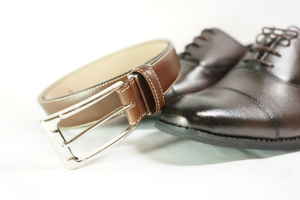Eco Leather is a Global Trend
 Eco Leather began developing and spreading in the mid-1990s, mainly in Europe, eventually growing to be a global trend. 2006 saw the establishment of the Japan Eco Leather Standard through the cooperation of an NPO, the Japanese Association of Leather Technology, and the Tanners' Council of Japan.
Eco Leather began developing and spreading in the mid-1990s, mainly in Europe, eventually growing to be a global trend. 2006 saw the establishment of the Japan Eco Leather Standard through the cooperation of an NPO, the Japanese Association of Leather Technology, and the Tanners' Council of Japan.
Certification under the standard has been managed by the Japan Leather and Leather Goods Industries Association since 2009.
Why Eco Leather?
The Japan Environment Association has adopted the Japan Eco Leather Standard as its standard for leather for use in the Japan Eco Mark Product categories of "bags and suitcases," "shoes and footwear," and "leather garments, gloves and belts."
Going forward, we believe that more and more Eco Leather products will appear on the market in the context of a growing trend towards an environmentally conscious society.
What kind of Leather is Japan Eco Leather?
As Japan Eco Leather continues to garner attention, it is worth asking, what kind of leather is Japan Eco Leather? The term refers to leather that complies with the Japan Eco Leather Standard, that has been recognized as having been made with attention paid to reducing its environmental load, and as having a low environmental impact throughout its entire life cycle, all the way through "product manufacturing, transport, distribution and re-use."
Certification under the Japan Eco Leather Standard is limited to "hide or skin with its original fibrous structure more or less intact and tanned to be imputrescible."
The following three types of leather are subject to the standard:
- Category 1: Grain leather from one of the major varieties of domesticated animal (bovine, horse, pig, sheep or goat)
- Category 2: Split leather made by re-using left-over flesh-side leather made as a by-product of the tanning process
- Category 3: Leather from animals other than those covered by categories 1 and 2. However, a proper transaction certificate from the relevant management authority is required.
The following three requirements are the major certification criteria
for Japan Eco Leather:
- It must be genuine leather (based on the definition of leather stipulated in JIS K 6556-1 and ISO 15115: 2019, Leather-Vocabulary. If the leather has a surface coating, the mean thickness of this surface layer, however applied, has to be 0.15mm or less. If the tanned hide or skin is disintegrated mechanically and/or chemically into fibrous particles, small pieces or powders and then, with or without the combination of a binding agent, is made into sheets or other forms, such sheets or forms are not leather).
- It must be leather that is made from hide or skin that was appropriately sourced, and that was manufactured at factories that appropriately manage waste water and the processing of waste materials.
- It must meet certain criteria with regard to scents, chemical components (formaldehyde, extractable metals, lead content, certain aromatic amines, nonylphenol, nonylphenol ethoxylate, short-chain chlorinated paraffin) and color fastness to rubbing of dyes, and must not use carcinogenic dyes or prescribed chemicals.
For further details, see "Japan Eco Leather Standard" and contact eco@jlia.or.jp.
Certification Labels that only Japan Eco Leather Certified Products can Use
Meeting the Japan Eco Leather Standard allows merchants to display the "Japan Eco Leather Certified Label" on certified leather or leather products using certified leather, on the basis of a Label Usage Contract.
Japan Eco Leather Certification Label
The Japan Eco Leather Certification Label is represented by a symbol consisting of the letters J, E, and L, standing for "Japan Eco Leather." The symbol also has a grand presence, with a seal or emblem-like element representing the Japanese character "日", meaning Japan (日本). The terms "SILVER" or "BRONZE" displayed alongside Japan Eco Leather indicate the certification level of the Japan Eco Leather-certified leather.

